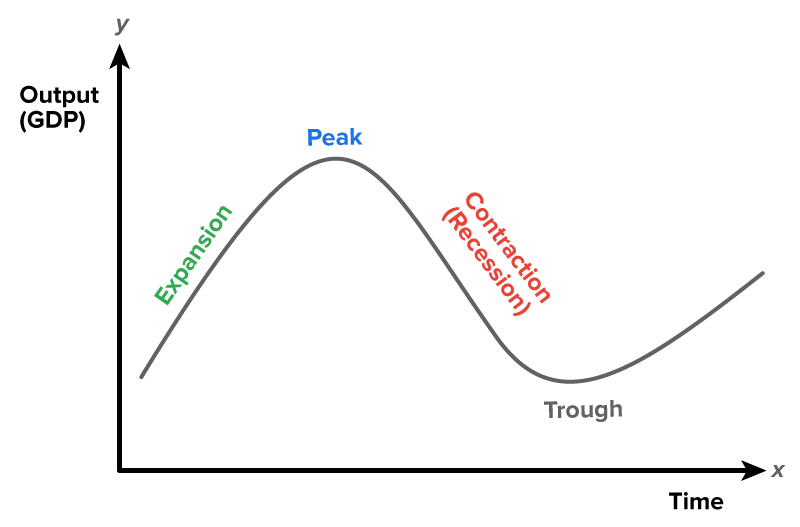Table of Contents |
This is a business cycle, which shows that it is normal for the economy to go through periods of growth (also known as expansion or a peak) and contraction (also known as recession or a trough).

At any given time, when thinking about the health of any economy, most people pay attention to the three key macroeconomic indicators: economic growth, full-employment and unemployment rates, and the consumer price index (CPI)/inflation rate.
However, economists use several kinds of data to help them track and measure these three primary economic indicators:
Leading indicators are trends, patterns, or situations that assist in forecasting the economy. They show us where the economy is headed, and they can be used by policymakers and business owners to predict future economic events and make economic decisions in the hopes of fostering economic growth and development, ceteris paribus (an economic term for “all other things being equal”).
Examples of leading indicators include the following:
Lagging indicators are trends, patterns, or situations that provide a clear indication of where the economy has been. Basically, they are after the fact, or confirm and provide evidence to evaluate how the economy reacted to the economic policies and decisions made by businesses and policymakers.
Examples of lagging indicators include the following:
Finally, a coincident index is an indicator that provides a view of the current state of the economy. These indicators help in monitoring the performance of the economy in real time.
A good example of a coincident indicator is a retail sales number, which is the subject of a different lesson. This economic indicator provides a snapshot of the performance at the moment.
Examples of coincident indicators include the following:
There are many indicators that help us assess the state of the economy. It is helpful to have multiple indicators because of the following:
EXAMPLE
If the state of Texas wants to increase its road construction expenditure, policymakers will have to analyze the following leading economic indicators:A favorable result from these indicators indicates that the economy is likely to see economic growth and development soon.
EXAMPLE
If Walmart wants to evaluate its performance in the context of the overall performance of the economy, its top executives will have to analyze the following lagging economic indicators:Companies like Walmart use these indicators to evaluate how favorable the economy is to invest in new products or discontinue existing projects.
EXAMPLE
If Equinox Gym decides to expand its space within the next two quarters of the year, its top business advisors will have to analyze the following coincident economic indicators:This is why it is helpful to have so many indicators.
| Indicators | Timing | Aim/Use | Economic Indicators | Example |
|---|---|---|---|---|
| Leading | Before economic trajectory | Predict future performance | Unemployment insurance claims, building permits, stock or equity market performance, and consumer and producer confidence index | The declining stock market, increasing approval of homeowners with bad credit, approval of new housing permits, and declining consumer confidence in late 2005–2006 suggested the 2007–2008 Great Recession. |
| Lagging | After economic trajectory | Confirm/evaluate past decisions/performance | Unemployment rate, consumer price index, producer price index, corporate profit margins (bottom and top lines), and consumer credit | The supply chain shortage, the high unemployment rate among nonessential workers, increased transfer payments through stimulus checks, and the Great Resignation period confirmed that the 2019 COVID-19 pandemic harmed the U.S. economy. |
| Coincident | During economic trajectory | Monitor current economic events and conditions | Retail sales numbers, subscription to service products, and labor participation index | Both local and international investment bankers use the current RGDP, labor participation rate, and retail sales data to monitor the momentum of the U.S. economy. |
Source: THIS TUTORIAL WAS AUTHORED BY KATE ESKRA FOR SOPHIA LEARNING. PLEASE SEE OUR TERMS OF USE.